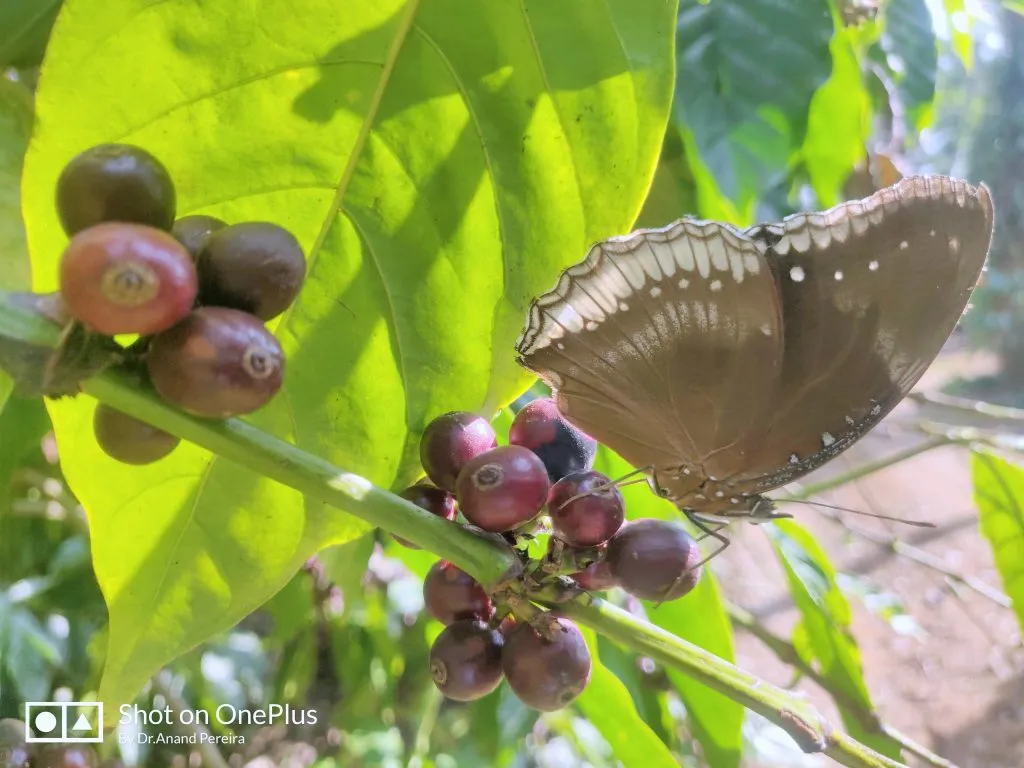by Dr. Anand Titus and Geeta N. Pereira
India’s shade grown ecofriendly coffee is cultivated under the canopy of tropical evergreen trees. The great variety of butterflies, in shade coffee is largely attributed to the abundant and wide spread food availability throughout the year alongside, water resources, varying habitats, which support a wide range of vegetation communities and diversity of plant species.
Although butterflies may seem like an attractive pollinator inside coffee Plantations, they are a more important insect than most planters realize. Butterflies have great value as indicator organisms and are important in describing ecosystem health and stability of the coffee ecosystem.. Butterflies can act as vibrant indicators in monitoring the health of the coffee ecosystem and its restoration success. A closer look at the butterfly population, and type of species, provides vital clues on weather patterns. These butterflies can tell us almost everything we need to know about the health of an ecosystem. Butterflies respond to tiny unseen changes in the environment and also act as an umbrella species which by and large benefits wider communities in a given ecosystem. Butterflies are sensitive to climate change, such as pollution and habitat loss, and cause them to be more responsive. Their reaction to environmental degradation or perturbations is amplified and rapid. Therefore, an abundance of butterflies usually indicates a healthier ecosystem.

Why Butterflies Act as Ecological Indicators of Healthier Ecosystem.
Review of Scientific Literature specifies that in 1988 Landres and Simberlof demonstrated that Indicator species point to the physical and chemical changes in the environment, or the abundance of other species through changes in their own abundance. These indicators were referred to as ecological indicators. The main goal of indicators is to measure the complex ecological system and its interaction with the biotic community. It is a well-accepted norm in many regions of the world, Lepidoptera are accepted as the ecological indicators of the ecosystem health.
What makes butterflies good indicators?
A butterfly’s metamorphosis involves four stages. The butterfly starts out as an egg, hatches as a caterpillar, turns into a chrysalis, and finally emerges as a butterfly. Butterflies have short life cycles which makes them ideal candidates to study their behaviour and how they react to environmental changes at each stage of metamorphosis. The Caterpillars specialisation on type of milkweed as food, also signals evolutionary biology.
Butterflies As Model Organisms
Butterflies have been used by ecologists as model organisms to study the impacts of habitat loss, fragmentation and climate change. Butterflies have clear taxonomy their biology and life history are well defined. Physiological tolerances; habitat, temperature, light requirements have been quantified and correlations with changes in ecosystem conditions have been determined.
Butterflies Promote biodiversity
Butterfly caterpillars feed on a variety of host plants. Plants in turn evolve defence mechanisms to survive predators. This results in more species variation and biological diversity.
Genetic Variation in Plant species
Some butterfly species migrate over long distance and share pollens across plants which are far away from one another.
Food sources
Butterflies are an important food source for many species, including other insects, birds, mammals and fish.
Decline
In the past one-decade butterfly and moth species have alarmingly declined in the tropical Evergreen forests of the Western Ghats. Even the abundance of common garden butterflies, has significantly dropped.
Migration
Some butterfly species show migratory behaviour, which is seasonal, and are restricted to a selection of habitats, and this is an indication of the richness of the biodiversity of that region. Many butterfly species migrate over long distances as many as 3,000 miles. These migrations allow for pollination across long distances.
But from the Meadow Brown to the Swallowtail, British native butterfly species are slowly disappearing.
Pollinators
Bees might do the bulk of the pollination work in nature, but some flowers have evolved to be pollinated best by butterflies.
Natural Pest Control
Area’s rich in butterflies are generally rich in flora and fauna. The interaction of butterflies with the surrounding ecosystem provides a wide range of environmental benefits including natural pest control. Some butterfly larvae feed on harmful insects like aphids so, caterpillars are also use as biological pest control.
Pollution Control
Some species of butterfly help to reduce the air pollution. These species decrease the carbon dioxide in the air.
Conclusion
The Coffee Forests are home to varied species of flora and fauna. We have many different organisms that detect minute changes in weather patterns or pollution levels. But Butterflies are increasingly being recognised as valuable environmental indicators, both for their rapid and sensitive responses to subtle habitat or climatic changes and their interactions with the biotic community. Hence it is desirable to map butterfly diversity in respective coffee Agroclimatic regions, their distribution patterns and abundance ,particularly lepidopterans that will provide a reliable barometer in gauging the health of the coffee ecosystem.
References
WHY ARE BUTTERFLIES IMPORTANT?
Why butterflies are beneficial to the environment.
6 Reasons Why Butterflies are Important